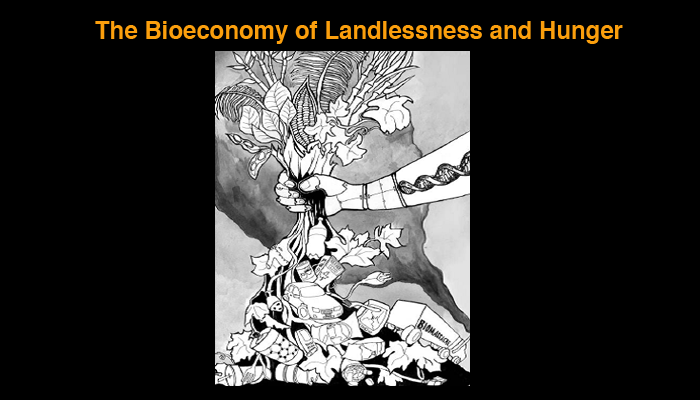by the ETC Group
Originally published by ETCGroup.org
For the full briefing please download the PDF file.
Synthetic biology represents a quantum advance on biotechnology, and goes beyond transferring genes between species to constructing entirely new, self-replicating microorganisms that have the potential (partially proven / partially theoretical) to convert any biomass or carbon feedstock into any product that can be produced by fossil carbons – plus many more. In other words, from the perspective of synthetic biology (“synbio”), the resource base for the development of marketable “renewable” materials (that is not from petroleum) is not the world’s commercialized 23.8 % of annual terrestrial biomass, but also the other 76.2 % of annual terrestrial biomass that has, thus far, remained outside the market economy.[i]
Synthetic biology has already attracted the attention of the United Nations and governments. The technology was on the agenda of the UN Convention on Biological Diversity that met in Hyderabad, India in mid-October 2012, with governments agreeing to continue monitoring the technology and report back to future meetings of the CBD.[ii]
At first blush, a new manufacturing platform built on “re-programming” life forms sounds like the stuff of science fiction and far removed from the realities of agriculture in the global South. However – like previous revolutions in agriculture and manufacturing – the Northern-bred synbio industry is shifting the economic picture for farmers in the South (and at greater speed), driving a new wave of land grabs (for biomass) and competing head to head with the naturally sourced commodities that Southern economies have relied on for decades or even centuries. As well as driving the biomass grab, it is increasing the economic value of natural gas through controversial ‘fracking’ processes: synthetic microbes are now being re-tooled to use natural gas as their carbon source.[iii]
Synthetic biology by the numbers
In 2012, the synthetic biology industry evolved into a global, well-financed and rapidly expanding sector with products already in the marketplace and many more in the pipeline over the next two to three years.
- Growing Fast: According to BCC Research, global synthetic biology product sales were around $1,600 million in 2011 and are expected to rise to $10,800 million by 2016.[iv] A recent survey identified almost 3000 active synthetic biology researchers in 40 countries funded by 530 different entities – primarily in the USA, Europe, China and Japan.[v]
- Switching Focus: Three quarters of the activity has so far been energy and chemical companies (such as BP, Shell, DuPont, Total) developing and marketing artificial microbes that produce next generation biofuels, bioplastics and commodity chemicals.[vi] However the industry is now rapidly switching focus to primarily produce materials formerly sourced from natural plant products –such as rubber, food flavours, fragrances and essential oils as well as natural medicinal products. The new waves of investors are the world’s largest cosmetics companies, flavours and fragrances brokers, pharmaceutical manufacturers and food ingredient producers (e.g., Novartis, Givaudan, International Flavours & Fragrances Inc., Roquette Frères).[vii] A third wave of Synbio partnership is also just beginning that will take advantage of transforming natural gas into high value products.[viii]
- Big Players: A 2011 survey by ETC Group and partners found that, overall, the leading global investors and developers of synthetic biology products remain six of the world’s ten largest chemical companies, six of the ten largest energy companies, six of the ten largest grain traders and the world’s seven largest pharmaceutical companies.[ix] Many of these in collaboration with financial players have in turn invested many thousands of millions of dollars of equity in over 100 ‘pure-play’ synthetic biology start-ups.
[i] 23.8% is the percentage of global net primary productivity that it is estimated is already appropriated by human activity. See Haberl et al., “Global human appropriation of net primary production (HANPP),” The Encyclopedia of the Earth, 29 April 2010.
[ii] Decision UNEP/CBD/COP/DEC/XI/11 paragraphs 3 and 4; 5 December 2012, “Decision Adopted By The Conference Of The Parties To The Convention On Biological Diversity At Its Eleventh Meeting, XI/11. New And Emerging Issues Relating To The Conservation And Sustainable Use Of Biodiversity:” http://www.cbd.int/cop11/.
[iii] See, for example, the gas to liquids technology developed by Calysta: Green Car Congress,“Calysta Energy engineering organisms to convert methane to low-cost liquid hydrocarbons; BioGTL process,” 22 October 2012: http://www.greencarcongress.com/2012/10/calysta-20121022.html.
[iv] BCC Research, “Synthetic Biology: Emerging Global Markets” November 2011 http://www.bccresearch.com/report/global-synthetic-biology-markets-bio06…
[v] Oldham P, Hall S, Burton G (2012) Synthetic Biology: Mapping the Scientific Landscape. PLoS ONE 7(4): e34368. April 23rd 2012. doi:10.1371/journal.pone.0034368
[vi] BCC Research, “Synthetic Biology: Emerging Global Markets” November 2011 http://www.bccresearch.com/report/global-synthetic-biology-markets-bio06…
[vii] Melody M. Bomgardner, “The Sweet Smell of Microbes” Chemical And Engineering News July 16 2012, Volume 90 Issue 29 | pp. 25-29
[viii] see Jim Lane,” The Gas Rush: Calysta Energy aims for high-value markets via unconventional natural gas” Biofuels Digest 22nd October 2012. Online at http://www.biofuelsdigest.com/bdigest/2012/10/22/the-gas-rush-high-value…
[ix] see page 13, International Civil Society Working Group on Synthetic Biology “A Submission to the Convention on Biological Diversity’s Subsidiary Body on Scientific, Technical and Technological Advice (SBSTTA) on the Potential Impacts of Synthetic Biology on the Conservation and Sustainable Use of Biodiversity” October 2011 –online at http://www.cbd.int/doc/emerging-issues/int-civil-soc-wg-synthetic-biolog…

